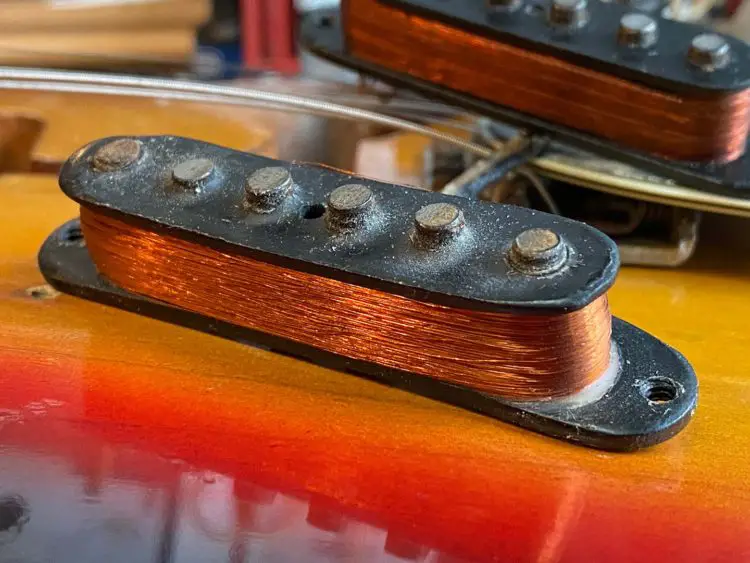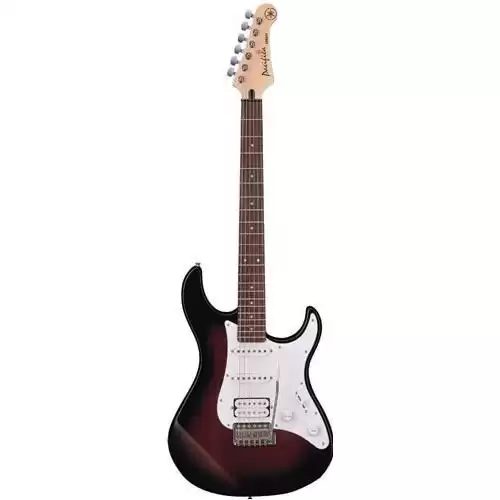Have you ever taken a close look at the different specification sheets out there for electric guitars?
You’ll find plenty of information about the different features and equipment included with the instrument. One of the areas of technical information that is the most valuable on these spec sheets involves the pickups.
You can see if the guitar has ceramic or alnico pickups. Different versions are sometimes installed, allowing you to see the potential performance capabilities of the product.
Although tonality is always subjective, almost everyone can hear a clear difference when evaluating ceramic vs. alnico pickups.
Ceramic vs. Alnico: Which Pickups Sound Better?
Ceramic pickups deliver a punchy tone with a higher output range in the treble frequencies. It feels harsh and compressed, but the notes also ring true. Alnico pickups offer sounds that are warmer and smoother, providing clean sounds that work well for blues, rock, and jazz because of the added articulation.
When comparing the differences between ceramic and alnico pickups, you’ll find that design, tone, and chemical composition tend to lead the discussion.
The physical differences between the two pickup types are found in their magnets. Although both are still regular guitar pickups that use metal poles with copper strands, the ceramic magnet is usually a material slab connected to the bottom. Alnico magnets attach along the pole pieces.
Ceramic pickups use a ceramic magnet to create sounds. Alnico is an acronym that stands for “aluminum, nickel, and cobalt.” The magnets are made from that allow.
Since the ceramic magnets are stronger, they tend to have a higher output for the guitarist to use. Alnico pickups might not have as much strength, but that enables them to have a warmer sound.
Ceramic vs. Alnico: What Are the Tonal Differences?
Ceramic pickups are often dismissed because they’re cheaper to produce. That means you typically find them on entry-level guitars, included with starter kits, or offered as a low-cost replacement.
Just because ceramic pickups are cheaper doesn’t mean they produce a worse sound than the alnico alternative. It’s just a “different” audio excursion a musician can produce with this option.
Artists like Eric Clapton and Jeff Beck use ceramic pickups all the time with their playing and recording duties.
If you play overdriven tones in your pieces or prefer a harder musical genre, the characteristics found in ceramics are often better than what alnico offers.
If you like having active pickups on a guitar, you typically have ceramic magnets. Humbuckers fit into this category with the onboard preamp included in the product.
The signal gets amplified to produce a high-output product that works with metal and other high-gain situations. You’ll need a 9V battery to have this option work.
Alnico pickups are a bit softer than their ceramic counterparts. That means you have a lower-output design to use, but it tends to be more responsive. When you hear a guitar making some sweet sounds, it’s probably using this option.
What makes the alnico pickup unique is the different alloy combinations you can try. When you see a guitar’s spec sheet, you might see Alnico II or Alnico V listed – that designation indicates the metal ratio. The fives tend to produce a higher output than the twos.
How Are Alnico Magnets Made?
The precise chemical composition within an alnico grading depends on the alloy’s composition. Although these magnets are primarily made from aluminum, nickel, and cobalt, there are other materials included.
Below you’ll find the typical composition of an alnico alloy used for a guitar pickup today.
| Alloy Material Found in the Alnico Pickup | Percentage by Weight in the Alnico Magnet |
| Aluminum (Al) | 6% to 13% |
| Nickel (Ni) | 13% to 26% |
| Cobalt (Co) | Up to 42% |
| Copper (Cu) | 2% to 6% |
| Titanium (Ti) | Up to 9% |
| Niobium (Nb) | Up to 3% |
| Iron (Fe) | Balance of What Remains (30% to 40%) |
Alnico magnets have been used for loudspeakers since the 1940s. That’s when the Alnico V alloy was developed, providing a high-energy output that worked well to amplify sound.
Although multiple Alnico alloys exist, only the Alnico II and Alnico V are typically used for guitar pickups.
If you have an Alnico II pickup, it is 10% aluminum, 19% nickel, 13% cobalt, and 3% copper. The remaining amount is iron. That gives it a maximum energy MGOe rating of 1.7 with 13.5 kJ/m3.
When you play with an Alnico V pickup, it is 8% aluminum, 14% nickel, 24% cobalt, and 3% copper. The remaining amount is iron. That gives it a maximum energy MGOe rating of 5.5 with 43.8 kJ/m3.
You won’t see any titanium in alnico magnets until you use the Alnico VI alloy, which is quite rare in the music world today.
If Both Magnets Use Iron, How Do They Create Different Sounds?
Ceramic magnets use iron oxide as the composite material. Most are not particularly strong because the ferrite foundation isn’t highly refined. The actual force is like what alnico products provide, but hard ferrite designs aren’t stable at a high temperature.
That’s why ceramic magnets and pickups are typically used when the price is the primary driver for the marketplace. If you’re looking at size or mass as the primary need, alnico is the better choice.
Just because iron is the foundation of each balance, that doesn’t mean the magnets sound, operate, or even look the same.
That’s the nature of using different metals in the alloy. By tinkering with each unique profile, you can develop fields that produce sounds in multiple ways.
The only exception is if you’re using sintered ceramics or alnico for the pickup foundation. These magnets get created by a pressed powder process, cast in a die that mimics the final shape.
Once prepped, the sintering process occurs at nearly 1,300°C in a hydrogen atmosphere to create fusion.
Sintered magnets are stronger than their cast alternatives, but they’re typically smaller and weigh less than 30g. That means they might not be the right size or shape for use in musical production needs.
What Are P90 Pickups?
A P90 pickup is an overwound single-coil design that uses alnico magnets. The pole pieces receive more copper wire than you’d get with a standard option.
That design element creates more output than normal for the pickup, allowing it to be similar to a humbucker without becoming one.
The P90 design was the alternative to use when a beefier sound was needed before the invention of the humbuckers. With the humbucker pickup, you receive two single-coils essentially wound together.
When you have a P90 pickup, you’ll notice more aggression than with a standard alnico or ceramic pickup. If you use a humbucker instead, the notable hum that comes from the instrument gets eliminated.
What Is the Best Way to Decide if I Want Ceramic or Alnico Pickups?
Every guitar sounds a little different. That means the only way to know for sure if you want ceramic or alnico pickups (or Alnico II vs. Alnico V) is to equip each one to the instrument.
Once you play a few chords and run the sustain, you’ll know if that’s a tone you want to pursue.
If you don’t have the time to keep swapping out pickups, it is sometimes helpful to compare the same guitar model. You’ll get a reasonable approximation of what your instrument would sound like under different conditions.
I’ve found the best way to compare the tone between a ceramic and alnico pickup is to use the Yamaha Pacifica guitar.
If you play the Yamaha Pacifica 112J, it comes with ceramic pickups. When you grab the Yamaha Pacifica 112V, you’ll get to use alnicos. Since these two designs are almost identical, you’ll get a good idea of what to expect.
Although the 112V is a budget-friendly guitar, it still produces a remarkably vintage sound. I love to route the audio track through a pedal case to give myself options during a live gig, especially when playing with a full band.
You always need to make some minor adjustments during the soundcheck based on the venue’s acoustics.
I prefer the alnicos because of my playing style. I listened to a lot of Steely Dan while growing up, so I worked hard to emulate my style from those influences. I want cleanliness and precision in my tone without it feeling like a punch in the face.
When I’m finished with a guitar solo, I want people to sit back and feel like they just had a homecooked meal made by their grandmother. The ceramic pickups don’t let me accomplish that.
The other reason why I prefer the Yamaha Pacifica 112V is that it looks and feels a lot like a Strat.
When you use the HSS configuration with it, you’ll notice clear notes and a nice heft to each impact without overwhelming the listener.
The design even incorporates the five-position selector to maximize your playing opportunities.
When to Consider Replacing Your Pickups
The best times to replace the pickups on the guitar are when they wear out, if a different sound is desired, or a switch from single-coil to P90 or humbuckers occurs. Ceramic and alnico options exist for both, ensuring that the instrument can perform as intended once the installation work is complete.
Although pickups can last for a long time, they’ll eventually wear out when you play a guitar for long enough. They can malfunction, receive impact damage, or deliver an outdated tone for how your music evolves.
That’s the perfect opportunity to decide if you want to begin changing your sound in significant ways.
Most luthiers and repair specialists recommend choosing the closest pickup replacement to your current option to maintain the instrument’s sound.
Although you can find different tone flavors, ranging from the classic hot-rod to a vintage humbucker, the underlying quality and warmth will remain the same.
I’ve always enjoyed swapping out my pickups from time to time to explore different sounds.
I never thought I’d move away from alnico pickups with my style, but I played a Yamaha Pacifica 112J at a music store one day to kill some time and fell in love with the sound.
I know it doesn’t compare to a Les Paul or a Strat, but the Yamaha with the ceramics hits those jarring background tones for my music that an alnico pickup can’t touch.
I love to overdrive the sound coming from the 112J to push the limits of the sound system while articulating notes with precision.
When evaluating ceramic vs. alnico pickups, your preference is what reigns supreme. Choose the sound you like the most, establish your sonic profile, and have fun seeing what you can do with a guitar!



